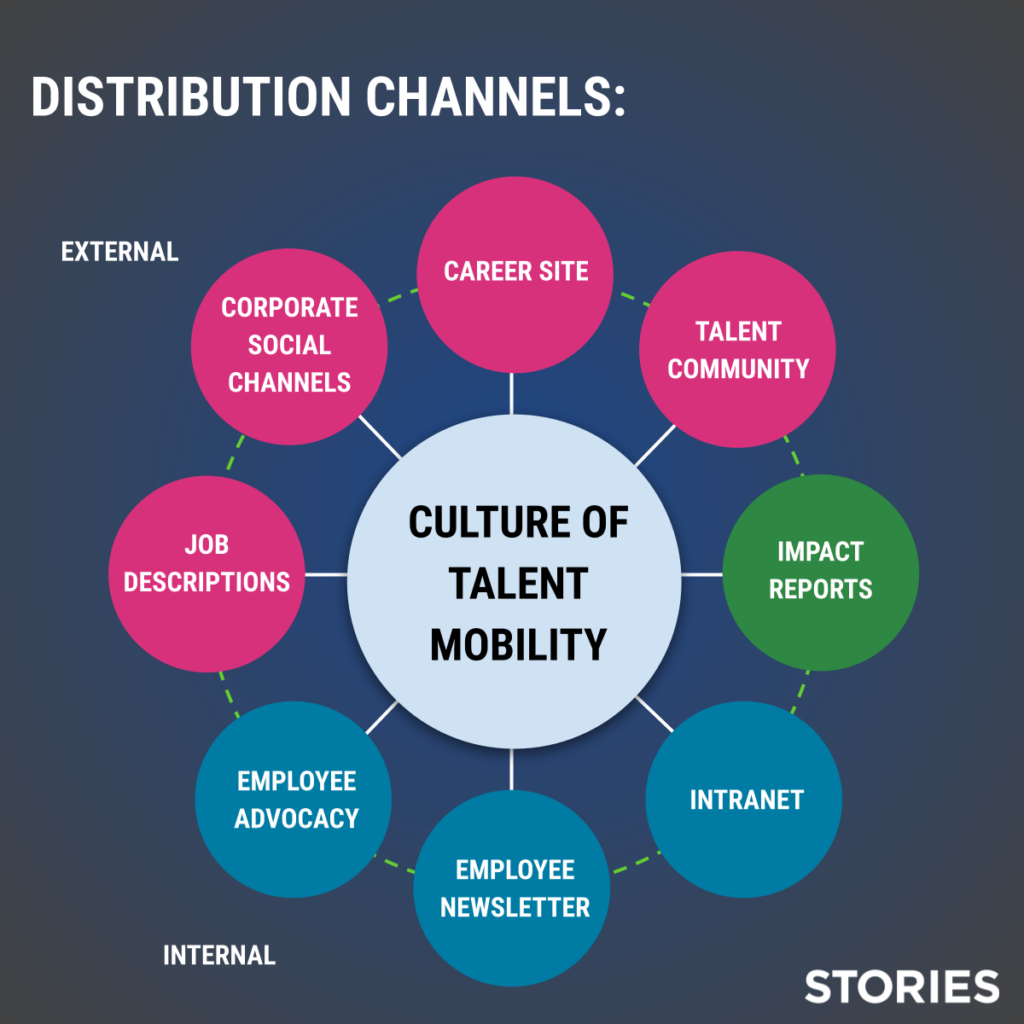4 Ways to Use Employee Stories in Your Talent Mobility Strategy
Career development is one of the top reasons people look for a new job. While this can be good news for your external recruitment efforts (eager-to-grow candidates, score!), creating a positive culture around internal career advancement is critical to retaining top talent already inside your company.
Enter your talent mobility strategy.
What is talent mobility?
Talent mobility is the ability for employees to move between different roles, departments, or locations within your organization as part of their career development. Many facets of your company culture impact talent mobility: visibility into other departments, mentorship, career development opportunities, emphasis on hiring internally, and more.
Data shows that investing in a strong talent mobility strategy is good for team members and business alike:
- 76% of employees say they are more inclined to stay in a company if it offers continuous learning and development.
- Employees who move into new jobs internally are 3.5X more likely to be engaged than those who stay in their current jobs and have a 64% chance of remaining with an organization after three years.
- Companies with lower turnover rates bring in four times higher profits on average.
If your company has established a positive culture around career development, showing examples of talent mobility at your company is going to be critical to your employer brand and employee engagement content strategy.
Employee stories are your best talent mobility strategy
If talent mobility is such a key differentiator for both candidates and employees, why do career sites often only offer generic statements like, ‘You can grow your career here’ or ‘Reach your fullest potential?’
Because career growth can look really different depending on the organization, employee stories are critical to showing what talent mobility looks like at your company. Career path stories reveal not just the steps in an employee’s career, but the details behind these job changes:
- Internal motivations
- Perceived (and real) obstacles
- Company programs that empower growth
- Mentors and motivators along the way
This talent mobility strategy works double duty: Externally, these stories prove to candidates how your culture supports professional growth in a tangible way. Internally, they inspire employees to take action in their own careers, too.
But, not all career path stories are created equal. After a decade-plus of creating employee story content, here’s our top four tips for telling an inspiring and substantive career growth story.
Be specific: share the story behind the job change
An internal mobility story shouldn’t read like a LinkedIn profile. The “how” and the “why” behind a career move is what provides talent valuable insight into your culture.
We love this employee spotlight from the tech company, Dropbox. In the story, Sheila shares how she came to lead the company’s major transformation initiative:
“One of the tenets in my career path is I actually really enjoy walking into things that need to be fixed. I was given an opportunity to lead a really large initiative that I knew nothing about. Our CTO at the time said, ‘Sheila. I have a really important project. I heard that you’re really good at executing and getting stuff done.’ The initiative was about a year and a half. I was given a date and a whole bunch of features and had to try to figure out how to string them together into a narrative that solves a problem for our customer. We had over 250 developers, it was the largest initiative that we had done to scale. I had an amazing experience doing that work and delivering. The trajectory has been vertical since then. Seize the opportunity, and make an impact. It’s opened so many doors.”
Sheila W., Sr. Engineering Director
This story highlights Sheila’s work approach and her ability to thrive in uncertain situations, which is an important aspect of working at Dropbox. You can watch the full video here.
Highlight the impact of professional relationships
Career decisions are rarely made alone. Mentors, managers, and beloved colleagues are often the supporting cast behind our biggest career decisions — so don’t leave them out of your stories!
Including these key conversations make your content more human and relatable. And, these details give insight into how your culture nurtures strong relationships. Win-win.
We love this story from Kiersten Combs, a marketing-turned-sales leader at the global pharmaceutical company, AstraZeneca. She shares how, when she was considering how to make the transition from marketing to sales, a colleague encouraged her to “go for the big job.”
Pro tip: “Is there anyone who supported you in this career move?” is a great follow-up question to help storytellers think of those who helped them along the way.
Your company is a character
Something your organization did (a benefit, policy, or culture element) made this story possible. Connecting these points in your story helps your company stand out and encourages participation in internal benefits and programs.
In this video from Precision Biosciences, two team members share how their careers benefitted from the company proactively sending them to conferences that helped them do their jobs better.
Show the story is the rule, not the exception
When it comes to company culture, don’t be a “one hit wonder.” By sharing multiple stories of internal mobility in action, it’s easy for talent to believe they could have the same experience, too.
As you build your career story library, this can be accomplished in a few ways. You can have many employee spotlights that speak to the same type of career progression. Or, you can create a compilation video that features multiple stories in the same piece of content.
In this compilation video from Sonoco, we hear three different storytellers share how the company culture encouraged them to step outside their comfort zone — and how their careers benefitted in the long run.
Where to share your talent mobility stories
Once you’ve uncovered your internal mobility stories, you’ll want to share them throughout your talent-facing channels. Externally, candidates will want to see this content on your career site, job descriptions, social media, and third party platforms like Glassdoor and Indeed.
Internally, you’ll want to weave these stories into your internal communications channels: newsletters, intranet, social media, physical bulletin boards, and any other touchpoints with employees.

By making the same stories visible internally and externally, you are reinforcing a cohesive message to candidates and employees alike: here’s how you can grow here, too.
What talent mobility stories will you tell?
If your company has established a positive culture around career development, employee stories are the best way to communicate what talent mobility looks like in your organization. Need help planning your storytelling project? Get in touch with our team!

